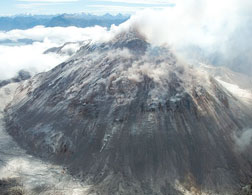Mother Earth Has a Fever
Should geoengineering tests be governed by the principles of medical ethics?
Nearly 200 scientists from 14 countries met last month at the famed Asilomar retreat center outside Monterey, Calif., in a very deliberate bid to make history. Their five-day meeting focused on setting up voluntary ground rules for research into cloud-brightening, giant algae blooms, and other massive-scale interventions to cool the planet. It's unclear how significant the meeting will turn out to be, but the intent of its organizers was unmistakable: By choosing Asilomar, they hoped to summon the spirit of a groundbreaking meeting of biologists that took place on the same site in 1975. Back then, scientists with bushy sideburns and split collars—the forefathers of the molecular revolution, it turned out—established principles for the safe and ethical study of deadly pathogens.
The planners of Asilomar II, as they called it, hoped to accomplish much the same for potentially dangerous experiments in geoengineering. Instead of devising new medical treatments for people, the scientists involved in planet-hacking research are after novel ways to treat the Earth. The analogy of global warming to a curable disease was central to the discussions at the meeting. Climate scientist Steve Schneider of Stanford talked about administering "planetary methadone to get over our carbon addiction." Others debated what "doses" of geoengineering would be necessary. Most crucially, the thinkers at Asilomar focused on the idea that medical ethics might provide a framework for balancing the risks and benefits of all this new research.
What would it mean to apply the established principles of biomedical research to the nascent field of geoengineering? The ethicists at Asilomar—particularly David Winickoff from Berkeley and David Morrow from the University of Chicago—began with three pillars laid out in the landmark 1979 Belmont Report. The first, respectfor persons, says that biomedical scientists should obtain "informed consent" from their test subjects. The second, beneficence, requires that scientists assess the risks and benefits of a given test before they start. The third, justice, invokes the rights of research subjects to whatever medical advances result from the testing. (The people who are placed at risk should be the same ones who might benefit from a successful result.)
Then Winickoff and Morrow proposed applying the Belmont principles to the study of the most aggressive forms of geoengineering—the ones that would block out the sun like a volcanic eruption, with a spray of sulfur or other particles into the stratosphere. Before we could embark on a radical intervention like that, we'd need to run smaller-scale tests that might themselves pose a risk to the environment. In much the way that a clinical drug trial might produce adverse reactions, so might a real-world trial of, say, the Pinatubo Option. Instead of causing organ failure or death in its subjects, a botched course of geoengineering might damage the ozone layer or reduce rainfall.
The problem, admitted the ethicists, is how to go about applying the Belmont rules outside of medicine. In clinical drug trials, researchers obtain consent from discrete individuals, and they can precisely define the worse-case outcome (like death). But a trial run of hazing up the stratosphere wouldn't affect specific, identifiable people in any one town, city, or state. The climate is interconnected in many ways, some still mysterious to scientists, and so the risks of even a small-scale test in a particular location might apply across the globe. If everyone on Earth could be affected, how do you figure out whom to ask for informed consent?
One possibility would be to require that all nations of the world agree ahead of time on any tests of consequence. To many gathered at Asilomar, however, this seemed naive; speakers repeatedly invoked the failure of all-inclusive talks to cut global carbon emissions, and it would presumably be much tougher to secure an agreement on work that might damage crop yields or open a hole in the ozone. A more pragmatic approach would be to set up something like a U.N. Planet Hacking Security Council, comprising 15 or so powerful nations whose oversight of research tests would take into account the concerns of a broad swath of countries. But that undemocratic approach would surely face howls of protest.
The principle of beneficence may be just as difficult to follow. Under the Belmont guidelines, doctors must balance the particular risks of a clinical trial with the potential benefit to any individual who might participate. Since it would be impossible to make such a calculation for every person on Earth, planet-hackers could at best choose the experiments that minimize harm to the most vulnerable communities—like people living on the coasts of Southeast Asia. But we may not know enough about the risks of geoengineering to make any such credible calculation when the time comes. Consider the Pinatubo Option, by which scientists would mimic the cooling effect of volcanoes. Putting particles in the stratosphere could reduce the total amount of energy that strikes the Earth. Some climate modelers say this would disrupt rainfall by reducing moisture in the atmosphere obtained by evaporation. Others say that geoengineering droughts and famines would be less harmful than those caused by unchecked warming. Right now, no one can agree on the nature of the risks, let alone the degree to which they would apply to particular communities.
And what about justice? Among the disruptions that could result from testing the Pinatubo Option is a weakening of the Asian monsoon, a source of water for hundreds of millions of people in India. Those in developing countries will "eat the risk" of geoengineering trials, shouted one of the climate scientists at Asilomar during his presentation. If representatives from just a small set of countries were appointed as doctors to the planet, then the less powerful nations might end up as the world's guinea pigs. Of course, the citizens of those nations also would seem to have the most to lose from uninterrupted global warming. These two dangers would have to be measured one against the other—and compensation as part of the experimental program could be one way of making tests more fair.
If medical ethics aren't quite up to the task of guiding our forays into geoengineering, what other sort of principles should we keep in mind? One important danger to be aware of is the moral hazard that might come with successful trials. That's the idea that protective circumstances or actions can encourage people to take undue risks—government insurance of banks led to risky investments that caused the savings-and-loan crisis in the 1980s, for example. Moral hazard looms particularly large for geoengineering studies since medium-scale field tests could prematurely give us the sense that we have a low-cost technical fix for global warming, no emissions cuts needed. (Moral hazard isn't quite as potent in medical research. The availability of cholesterol-lowering drugs may well discourage people from maintaining healthy diets, but it's unlikely that mere clinical trials would have the same effect.)
Another ethical principle that might apply to geoengineering is minimization—the idea that, a priori, it's better to tinker at the smallest-possible scale necessary to answer vital scientific questions. This notion comes from the ethics of animal experimentation; now we might apply it to planetary systems and the environment more broadly. Up until now, the medical ethics frame for geoengineering has guided discussions of how geoengineering might affect people in various countries. Perhaps we should be talking about how it affects the planet itself.
By that token, we might gain something by thinking of the Earth as a patient on its own terms. The rules and regulations we come up with for tests of geoengineering should take into account the way those experiments might affect ecosystems and nonhuman animals, both under threat from warming. And so maybe the most famous piece of medical ethics ought to apply: the Hippocratic Oath. "First, do no harm" is the crux of the original, but an updated version exhorts doctors to avoid "the twin traps of overtreatment and therapeutic nihilism." The climate crisis may force us to act despite myriad ethical challenges, for our benefit and for the planet's.
This story was produced by Slate for the Climate Desk collaboration. Become a fan of Slate on Facebook. Follow us on Twitter.


